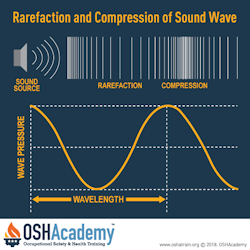Noise and Hearing Loss
Sound and Noise - What's the Difference?
Sound - consists of pressure changes in a medium (usually air), caused by vibration or turbulence.
These pressure changes produce waves emanating away from the turbulent or vibrating source.
Noise - is nothing more than unwanted sound. Noise is one of the most widespread occupational health problems. It is a by-product of many industrial processes.
Check out the short video clip by Dan Clark of that gives a quick overview of nature of sound, noise, and ways to prevent hearing loss in the workplace.
How is Sound Measured?
Sound is measured in two ways: decibels and frequency.
Decibels measure sound pressure. Frequency is related to a sound's pitch and is measured in units called hertz (Hz), or cycles per second. The pitch of a sound - how high or low it seems - is how you perceive its frequency; the higher the pitch, the higher the frequency. High-frequency sounds are generally more annoying than low-frequency sounds and can be more harmful to hearing.
Human hearing is most sensitive to frequencies between 3,000 and 4,000 Hz. That's why people with damaged hearing have difficulty understanding higher-pitched voices and other sounds in the 3,000 to 4,000 Hz range.
Knowledge Check Choose the best answer for the question.
1-1. Noise is nothing more than _____.
You forgot to answer the question!

